Delicious And Easy No-Knead Bread Recipe
Here's the easiest way to make rustic, delicious artisan bread at home! You don't have to make a starter and feed it, and you don't knead this bread either. This is the best no-knead bread you will ever make! In fact this dough is a master dough you can keep in the refrigerator for up to four weeks. And it makes 4 glorious loaves of bread.Jump to Recipe
Have you ever considered making your own delicious bakery-style loaf of bread? Can you imagine its wonderful aroma filling your home as it bakes? Can you see a loaf of this beautiful bread with its chewy crust and soft crumb on your table? Today, I’m thrilled to show you just how easy it is to make a loaf of delicious no-knead, no starter bread!
This post contains affiliate links. That means when you click on some of the links in this post and you make a purchase I earn a small commission at no cost to you. All my opinions are my own. You can view my full disclosure here.
I LOVE making this no-knead bread. And it is such an easy and special recipe!
This recipe makes enough dough for four loaves of bread. Just keep the dough in your refrigerator and pull off a chunk to make into a loaf of fresh crusty homemade bread whenever you want!
And the best part… you can make the dough and keep it in your frig for two weeks!
WHAT IS NO-KNEAD BREAD?
Oh, I’m so glad you asked!
No-knead bread is the easiest way to make a delicious real bakery-style loaf of bread! No-knead means just that. You do not knead this bread!
Kneading dough makes those wonderful strands of gluten that make the crust and crumb of the bread that gives it texture. But this can be achieved in a much easier way than kneading!
Instead of kneading dough, we can achieve those relaxed glutens by giving the dough a longer time to rest and develop on its own! And this is achieved by mixing up a dough recipe and letting it develop in the refrigerator! This also helps to develop the bread’s suburb flavor.
So when you are ready to make a loaf or boule of bread the dough is ready and waiting for you!
It is really that easy!
MY BREAD MAKING STORY
I’ve loved the idea of making bread for decades! I loved the idea of it, but because I’m not much of a baker I really did not dip my foot into the bread-making waters until a couple years ago!
Instead, I made delicious quick breads for my family. You can see my recipe for BUTTER TOPPED BEER BREAD here. And a delicious IRISH SODA BREAD here.
Then I got a bit braver and started to make sourdough bread using a starter. Unfortunately, I killed many a starter! It was a lot of work, waste, and a commitment to make a loaf of bread.
I tried so many different recipes and ways to make sourdough with a starter. I eventually came to the conclusion that making bread from a starter was not for me!
Then one glorious day I was watching Zoe Bakes on the Magnolia channel and she baked bread. Her method seemed so easy. So I decided to give bread making another try using her somewhat unorthodox but genius method.
And it was easy! And the bread was delicious! And there was no starter, no feeding, no waste, and no kneading or great commitment!
This was the first loaf of no-knead bread I made!
I’ve been making this 5-minute a day bread for months! After making this bread I tweaked the recipe to make it mine. I found that the dough was just a little too dry and by adding only 2 more tablespoons of water the dough was perfectly shaggy!
This bread is so worth making!
I got The New Artisan Bread In 5 Minutes A Day Cookbook a couple of weeks ago and I love it! It explains everything about making this bread along with so many other variations that can be made with one master dough! It is my new breadmaking bible!
WHAT MAKES THIS RECIPE SO DIFFERENT FROM OTHER NO-KNEAD BREAD RECIPES?
There are many yummy reasons for making no-knead bread but this recipe is amazing.
Here are six reasons this bread is so different from other no-knead bread recipes…
1). This dough makes a big batch of dough. You make one master dough that makes four loaves of bread. Less work for sure!
2. The dough is made in a container with a lid and kept in the refrigerator for up to two weeks.
3. When you want a loaf of bread you can pull off a chunk from the master dough, form it into a loaf, let it rise, and then bake it off.
4. To make another big batch of master dough after you have made 4 loaves of bread, whip up a new batch of master dough and incorporate a small amount of dough from the previous batch
5. This dough does use yeast but can easily become a sourdough.
6. There is no long rising time!
When you have a hankering for wonderful, artisan bread you have the dough ready and waiting for you! This is the magic and genius of this wonderful bread!
THINGS TO KNOW TO MAKE NO-KNEAD BREAD SUCCESSFUL
Okay, this is the hand holding part of this post. It’s important to me to help you make the best bread by giving you important tips and things to know about this bread making process! So don’t get overwhelmed! This bread is so super easy to make!
Follow the process and you will become a seasoned bread baker in no time at all!
It’s best to start out by using all purpose flour to get the best results. As you get accustomed to no-knead bread baking you can try different varieties of flours such as whole wheat flour, bread flour, or rye.
You can use any kind of yeast. Regular active dry yeast, rapid rise yeast, instant yeast, or even block yeast! It really doesn’t matter. You just want to use the yeast before the expiration date.
There are only four ingredients in this bread, flour, yeast, salt, and water. Today’s recipe is for a “master dough” that can then be tweaked and turned into all sorts of other delicious baked bread and other things.
Stir the ingredients together to get every speck of dry flour incorporated into the dough. This is called hydrating the flour because you are getting it wet so it can become dough.
You can scrape down the sides of the container with a bendable plastic scraper after you mix the ingredients to make the dough.
And you can even use a stand mixer or immersion blender to mix the dough together, but the dough comes together so quickly why dirty a large bowl or small appliance!
The master dough is sticky or shaggy.
If the dough is too dry add more water a little at a time. However, if the dough is too shaggy just add a little bit of flour. If the dough gets too dry it will be tough.
Do not knead this dough! Remember it is a NO-KNEAD bread recipe.
The bread needs to be shaped and left to rest for at least 40 minutes. I like to let my dough rest for up to two hours if possible covered loosely with plastic wrap. I would not suggest covering the dough with a cotton towel or a terry towel because they must be heavily dusted with flour so they don’t stick to the dough.
The instructions for forming the dough are in the recipe. Just remember to make a nice taut ball with the seam side down.
The longer the dough rests the more developed the flavor. And it will rise a little too, but not a lot.
The bread needs steam and heat to rise in the oven, creating a crackling crust and a tender crumb.
Before the bread goes into the oven it needs to be scored. This means the dough should be slashed about 1/2 inch thick from almost one end of the bread to the other. Or a series of decorating slashes can be made instead. This lets extra steam escape so the steam does not blow out the sides of the bread.
There are many different vessels you can bake this bread in. I love to bake bread in my enamel cast iron dutch oven with a lid. An inverted pyrex glass casserole with a glass lid can also be used as well as a ceramic baker. Other great options are rimmed baking sheets or an oven stone.
We will talk about these later in the post.
Bake the bread in a 450-degree oven.
The crust should be a dark golden brown when it is done and when the bottom of the loaf is tapped with your finger it should have a nice hollow sounding thud.
I know you will want to cut this bread when it comes out of the oven piping hot. You should wait till it is room temperature. But go ahead and cut a little end off and slather it with butter and enjoy! I do!
Let’s talk for a minute about making more batches of master dough. To make another batch of master dough you will need to hold back a baseball size piece of dough from your first batch.
Then add the flour, yeast, salt, and water called for in the recipe. Mix all the ingredients together until everything is incorporated. Scrape down the sides of the container and mix that into the dough. Let the container set out on the counter for two hours and then stick it into the refrigerator. The master dough will last for two weeks. Continue this process over and over again!
Don’t wash out the dough container when you make a new batch of master dough. Just scrape the dried dough down into the container and incorporate it into the master dough. This will help develop the flavor of the dough.
We will discuss more helpful tips as we discuss how to make this incredible bread!
THINGS YOU NEED OR THINGS THAT ARE HELPFUL TO MAKE NO-KNEAD BREAD
This bread is so simple to make and you can be a very successful no-knead baker with just a few pieces of equipment.
However, I’m giving you an equipment list with all the bells and whistles! The starred items are basic things you will need.
- a container with a lid to make and store the master dough*- see my pick here
- measuring cups and measuring spoons for dry ingredients*
- measuring cup for wet ingredients*
- wooden spoon* or a danish bread whisk- see mine here (I love this little whisk)
- parchment paper*- see the parchment paper here
- plastic wrap*
- pizza peel with cornmeal
- a vessel to bake the bread in, choose one*- a dutch oven, a cast iron pot with a lid, 2 rimmed baking sheets, inverted pyrex round glass casserole with a lid, or a pizza stone
- plastic scraper
- hot pads or oven mitts*
- sharp knife* or bread lame
- wire cooling rack*
- serrated knife- my favorite*
- cutting board- my favorite*
WHAT IF YOU DON’T HAVE A DUTCH OVEN
I make my bread in a dutch oven I have had for over three decades!
As I stated above the bread needs steam to rise and create a beautiful crust and crumb. And the enclosed environment of a dutch oven is perfect for the job!
If you don’t have a dutch oven you can make a very successful loaf of crusty artisan bread by inverting a glass pyrex casserole dish with a lid, using the lid to put your bread on, and covering it with the casserole.
Or you can make a very lovely loaf of bread by putting the dough on parchment paper on a baking sheet. First, put an empty baking sheet on the bottom of your oven and heat the oven to 450 degrees. When the oven reaches 450 degrees put the baking sheet with the bread on it in the middle of the oven and add boiling water to the baking sheet on the bottom of the oven until about half full. Then quickly shut the door! You want to capture as much of the steam as you can in the oven.
LET’S MAKE THIS BREAD
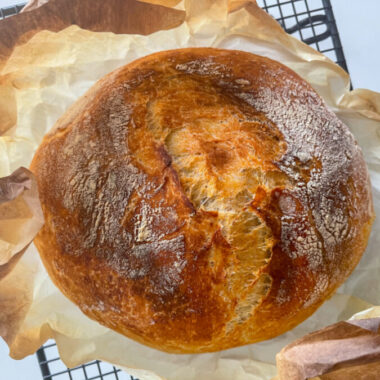
NO-KNEAD 5 MINUTE A DAY BREAD RECIPE
Ingredients
- 6 1/2 cups all purpose flour
- 1 packet or 1 TBS any kind of yeast
- 1 1/2 TBS kosher
- 3 cups plus 2 TBS cold or room temperature water
Instructions
MAKING THE DOUGH
- Combine flour, yeast, and salt into a 5-6 quart plastic container with a lid and stir using the handle of a spoon or a Danish dough whisk.
- Add the water and stir until all the flour is incorporated. This dough should be shaggy.
- Place the container of dough on the countertop with the lid off for two hours. Slight bubbles might start to appear. You can make bread with this dough but the flavor and crumb might not be fully developed. However, it will make a very acceptable loaf of bread.
SLOWLY BUILDING UP GLORIOUS GLUTEN STRANDS IN THE REFRIGERATOR
- Put the lid on the container and crack it. DO NOT put the lid on tight! Gasses will need to escape from the container.
- The next day you should see bubbles as the yeast is giving off gasses and the gluten strands are beginning to form. The dough is ready to make bread.
- This dough will make four 1 lb loaves of bread. Just lop off a chunk of dough the size of a grapefruit for the bread. The dough will last about two weeks in the refrigerator.
RESTING AND SHAPING THE DOUGH
- Put the dough taken from the master dough on a floured work surface. Form the dough into a ball by gently stretching the dough just a little and tucking the dough underneath itself with cupped hands. Give the dough a slight turn and continue gently and quickly tucking the dough under itself. Repeat until the dough forms a ball with a taut feel. Pinch the bottom of the dough together making a dough seam on the underside of the ball. This will create a boule (boul).
- Crumple and then flatten out a piece of parchment paper and put the dough in the middle of the parchment paper and loosly cover it with plastic wrap.
- Let the dough rest for 40 minutes or up to 2 hours. It will get just a bit larger depending on how hot or cold your kitchen is.
BAKING THE BREAD
- Preheat the oven to 450 degrees for 20 minutes before the boule goes in to bake. Put a dutch oven with the lid in the oven when it begins to preheat.
- When the 20 minutes is up, take the plastic wrap off of the boule and give it a good dusting with all purpose flour.
- Using a sharp knife, slash a half-inch deep cut into the top of the bread. Cut the boule almost end to end. This will give the steam a place to escape so the bread does not blow out at the sides.
- Pick up the parchment paper with the boule and gently place it in the dutch oven. Put on the lid and bake in the center of the oven for 25-30 minutes.
- Take the lid off of the dutch oven and you will see the bread has risen and is starting to brown.
- Put the dutch oven back into the oven without the lid and bake for an additional 15 or 20 minutes or until the bread is dark golden brown.
- Remove from the oven.
- Take the boule out of the dutch oven with a spatula, and put it on a wire rack to cool. Remove the parchment paper from the boule when it is cool enough to handle.
- Wait until the bread is at room temperature, slice, and enjoy!
TO MAKE ANOTHER BATCH OF MASTER DOUGH
- To make another batch of master dough you will need to hold back a baseball size piece of dough from your first batch. Add the small piece of dough and the flour, yeast, salt, and water as called for in the recipe to the container.
- Mix all the ingredients together until incorporated. Scrape down the sides of the container and mix the dried scrapings into the dough.
- Let the container set out on the counter for two hours and then stick it into the refrigerator.
- The master dough will last for two weeks.
- Continue this process over and over again to make delicious no-knead bread!
If you have wanted to make bread I hope you will give this delicious no-knead bread a try!
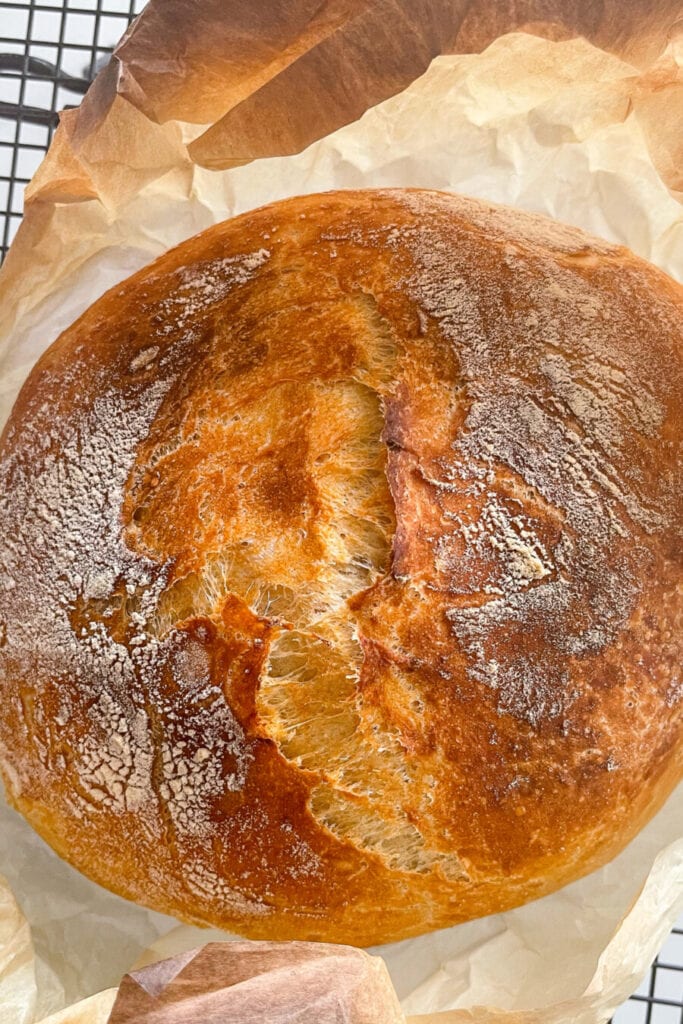


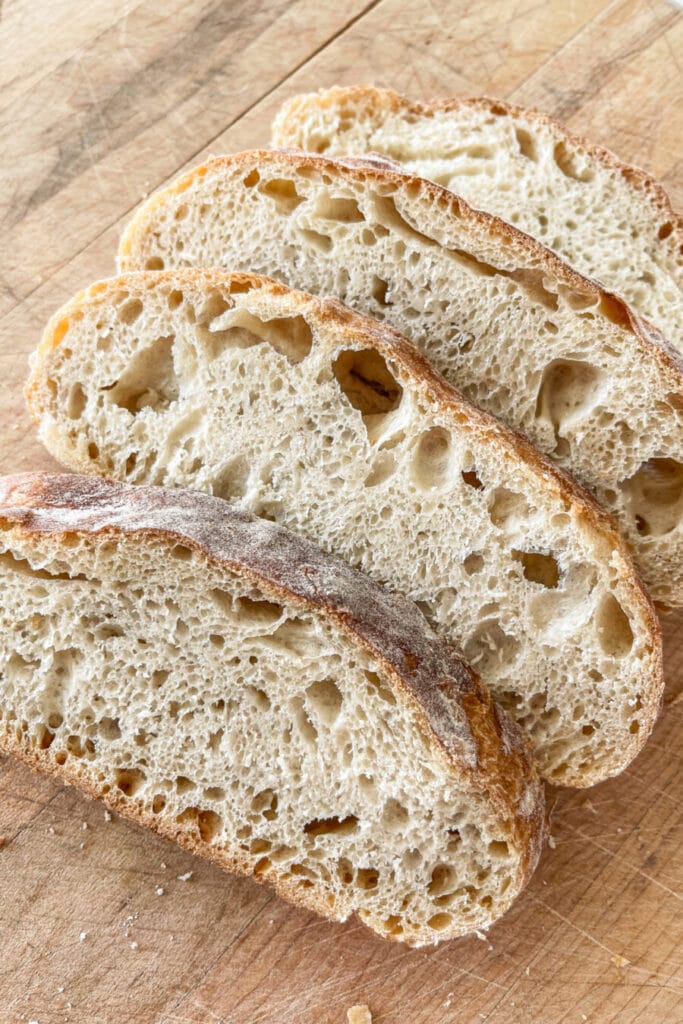
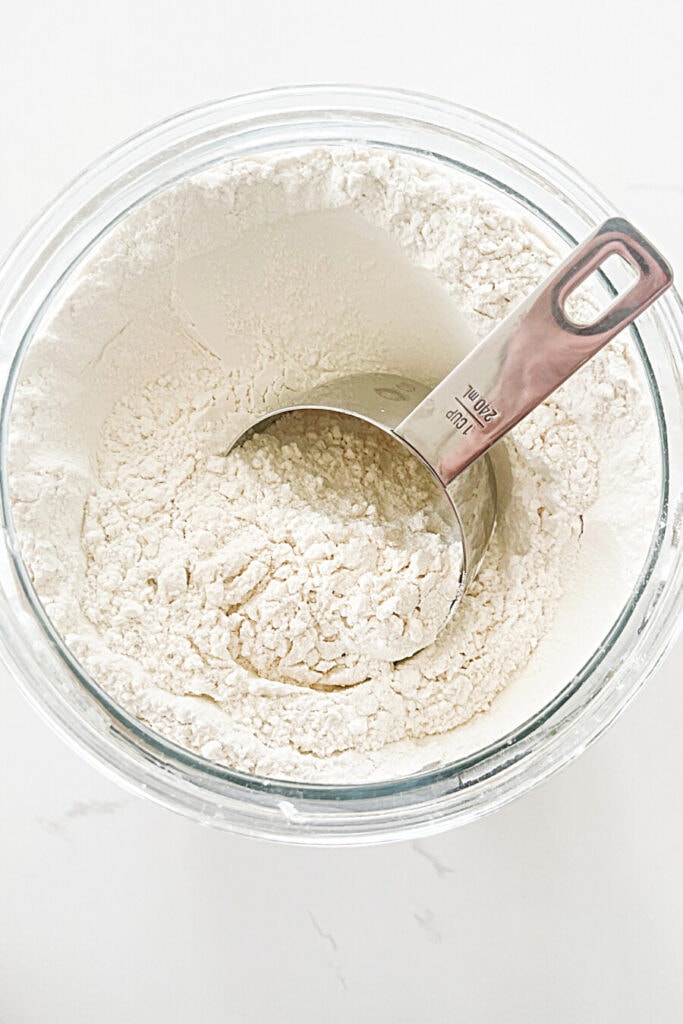
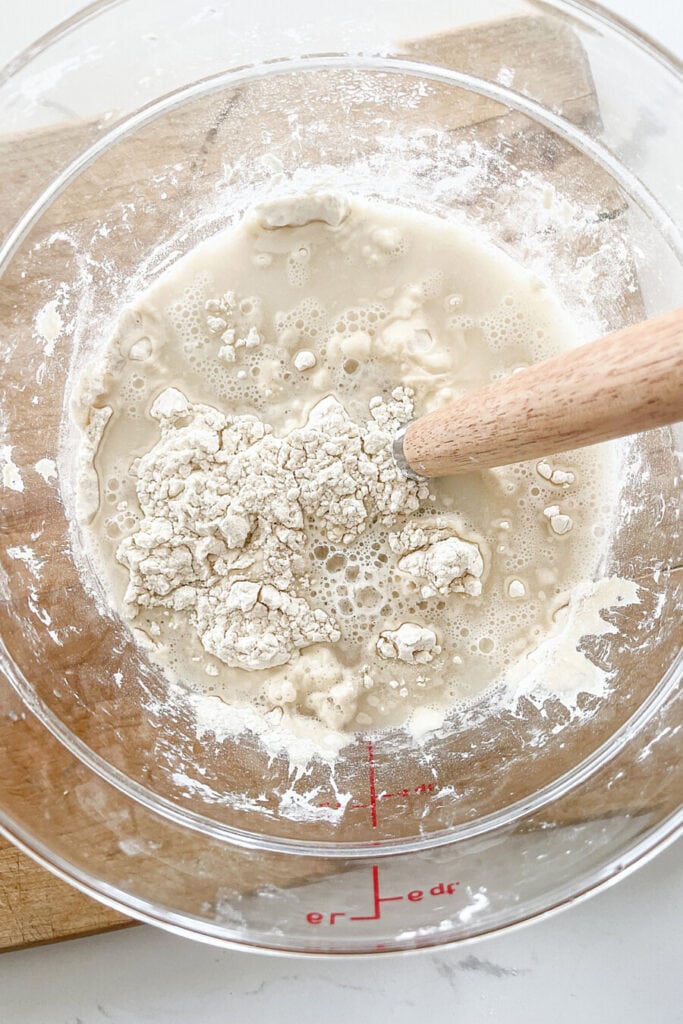
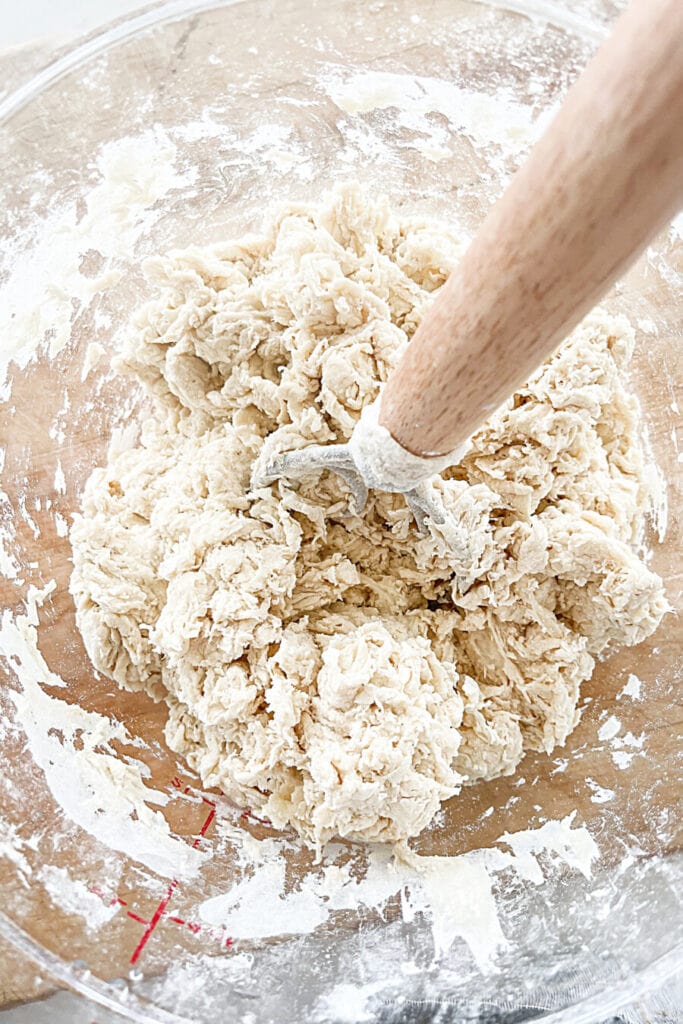
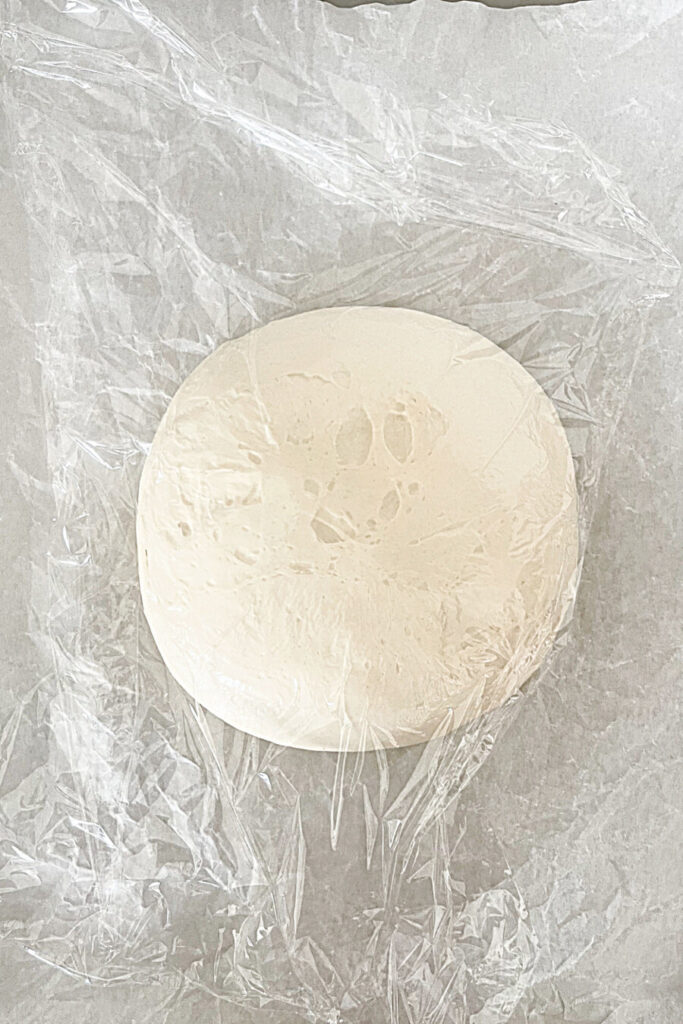
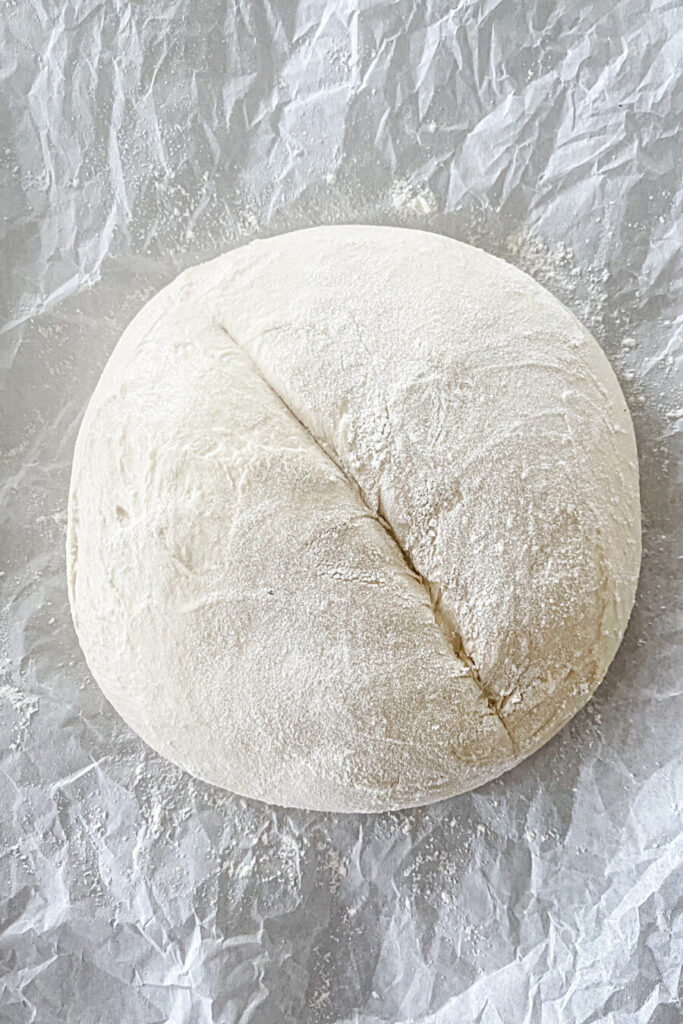
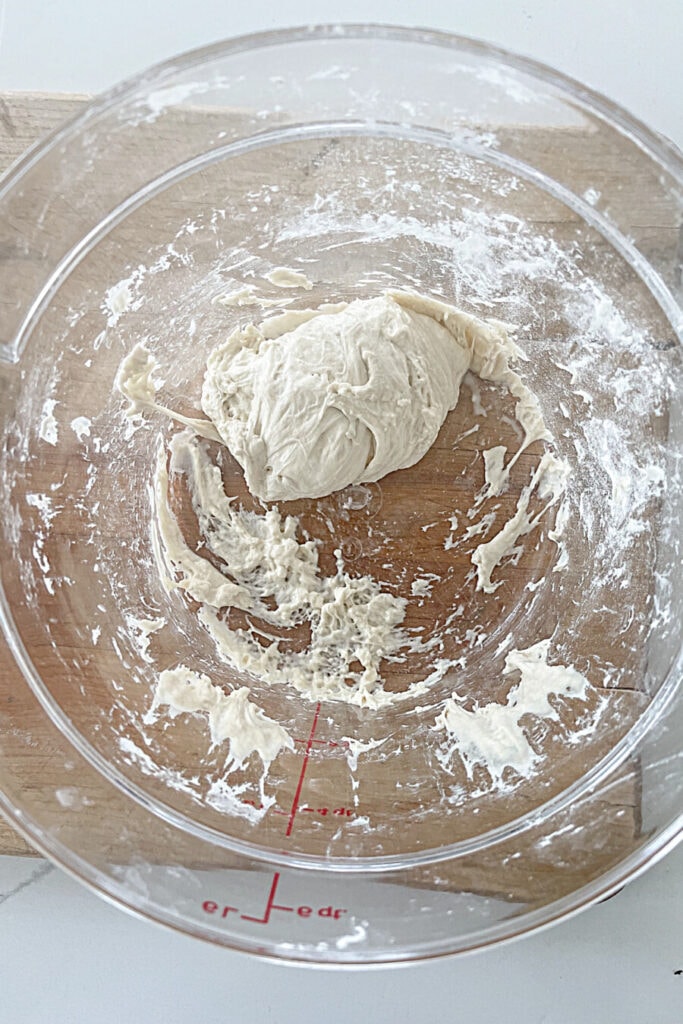

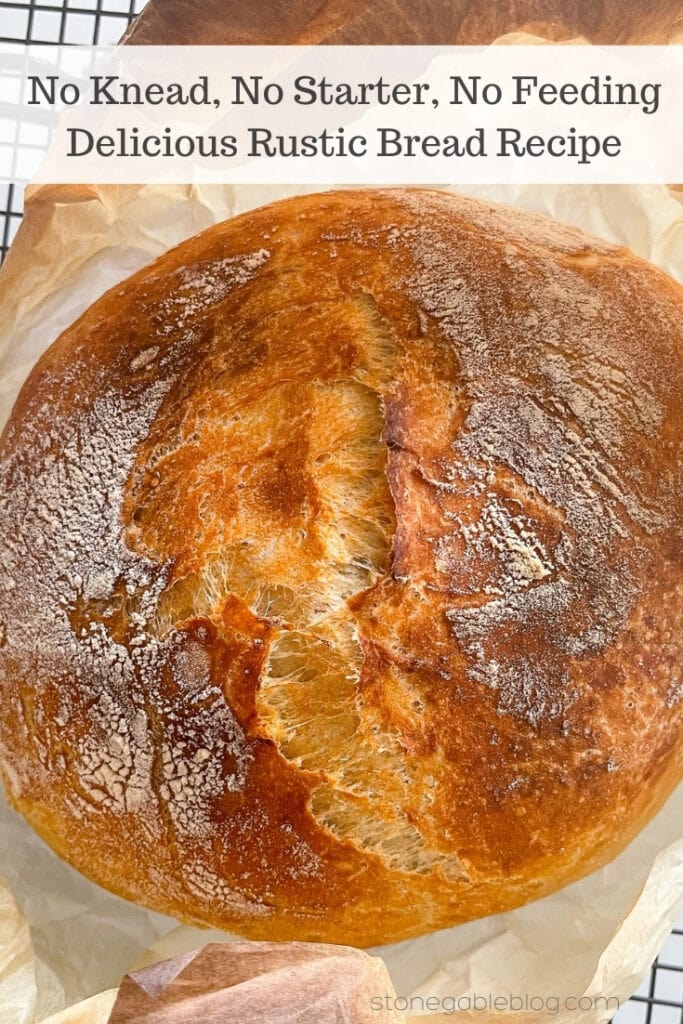
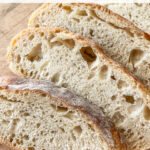
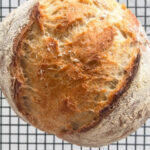
If I made the recipe by hand, do you think it could be baked in an electric bread maker?
I’m not sure! Sorry! I no longer have a bread machine to even give it a try. I think you would lose that gorgeous rustic crust in a bread machine.
Fascinated by this recipe and have 2 questions; I tend to do have cravings so Im wondering if I can just always make the master dough from the original recipe. Is there a difference in the taste?
And also why do you crumble up then flatten the parchment paper?
Great questions, Mary! I’ve made just the master dough recipe for the last five months. So you can just keep using the master dough. It is so so good. I crumple up the parchment paper so it is easier to fit in the dutch oven.
Do you have a high fiber, no knead bread recipe that would be acceptable for diabetics to eat?
No, not yet. Right now I’m just making bread with white flour. I’m not quite sure how to adjust this recipe for diabetics. However, I bet there is a recipe in the book I featured that might work.
Looks delicious but is there any way that this can be made in a regular bread/loaf pan? Growing up I had friends with grandmothers that made home made bread every week but all were made in pans and looked like loaves of bread.
Marge, give it a try. This bread is very versatile.
I am a notorious bad bread baker, but I’ll give this a shot! Printing it now!
Yay! I have found so much success with this bread.
Yvonne, thanks for this yummy recipe! I am going to make this bread tomorrow! Have a blessed day!
Let me know how it goes.
I don’t understand why you have to save some from the first batch to make the second batch. Why can’t you just make the second batch as you made the first? I wouldn’t be making a second batch within two weeks of making the first batch. So the small amount I saved from the first batch would go bad since you can only keep it for two weeks.
Hi, Linda. I have the same question, but you never got an answer. Did you ever figure out why?
Hi Lynn, I’m sorry you think you never get an answer. The reason you keep a bit of the dough and make new dough with it is for flavor. The old dough has aged a bit and has lot of natural yeast. It makes the bread taste better. And if you continue doing this you eventually get a nice sourdough!
Wondering if I could freeze the dough and thaw as needed as my family would never eat this much bread in 2 weeks?
Yes, you can freeze the dough.